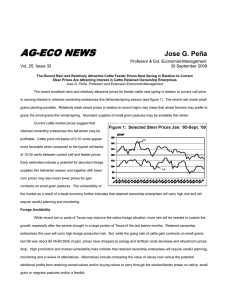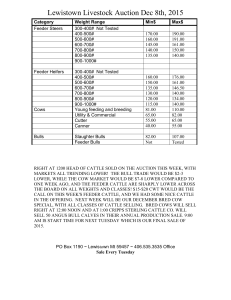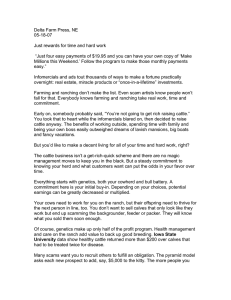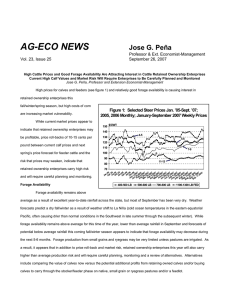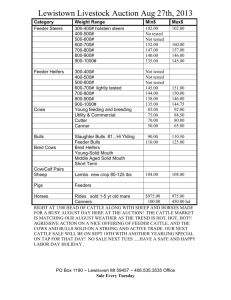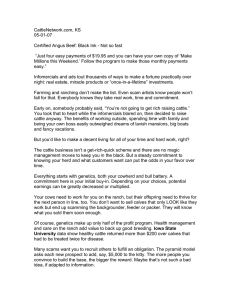AG-ECO NEWS Jose G. Peña
advertisement
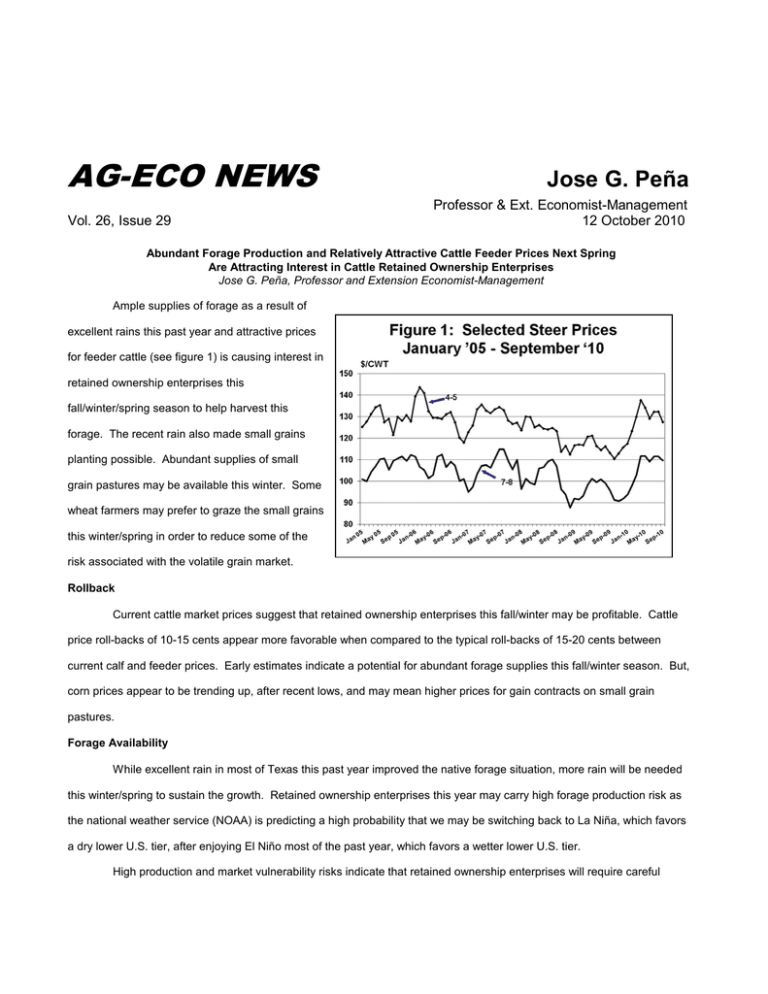
AG-ECO NEWS Vol. 26, Issue 29 Jose G. Peña Professor & Ext. Economist-Management 12 October 2010 Abundant Forage Production and Relatively Attractive Cattle Feeder Prices Next Spring Are Attracting Interest in Cattle Retained Ownership Enterprises Jose G. Peña, Professor and Extension Economist-Management Ample supplies of forage as a result of excellent rains this past year and attractive prices for feeder cattle (see figure 1) is causing interest in retained ownership enterprises this fall/winter/spring season to help harvest this forage. The recent rain also made small grains planting possible. Abundant supplies of small grain pastures may be available this winter. Some wheat farmers may prefer to graze the small grains this winter/spring in order to reduce some of the risk associated with the volatile grain market. Rollback Current cattle market prices suggest that retained ownership enterprises this fall/winter may be profitable. Cattle price roll-backs of 10-15 cents appear more favorable when compared to the typical roll-backs of 15-20 cents between current calf and feeder prices. Early estimates indicate a potential for abundant forage supplies this fall/winter season. But, corn prices appear to be trending up, after recent lows, and may mean higher prices for gain contracts on small grain pastures. Forage Availability While excellent rain in most of Texas this past year improved the native forage situation, more rain will be needed this winter/spring to sustain the growth. Retained ownership enterprises this year may carry high forage production risk as the national weather service (NOAA) is predicting a high probability that we may be switching back to La Niña, which favors a dry lower U.S. tier, after enjoying El Niño most of the past year, which favors a wetter lower U.S. tier. High production and market vulnerability risks indicate that retained ownership enterprises will require careful planning, monitoring and a review of alternatives. Alternatives include comparing the value of calves now versus the potential additional profits from retaining owned calves and/or buying calves to carry through the stocker/feeder phase on native, small grain or ryegrass pastures and/or a feedlot. Lower Cattle Inventory Calf and feeder prices have improved significantly as a result of a lower cattle inventory, relatively manageable feed costs and indications of a slowly recovering U.S. economy. The U.S. cattle inventory on July 1, 2010 decreased for the 4 th year in a row to the lowest herd size since the late 50’s, down 1.2 million head from an inventory of 102.0 million head on July 1, 2009. The 2010 calf crop is estimated at 35.4 million head, down 419,000 head from a calf crop of 35.81 million in 2009 and down 713,000 head from a calf crop of 36.113 million head in 2008. Feeder supplies will remain in short supply unless feeder cattle imports from Mexico increase. Increased demand from a reduced inventory of feeder cattle appears to be influencing the market improvement. In addition, while the cattle mid-year report appeared to indicate a potential for a continuation of the reduction in the size of the U.S. cattle herd, there are slight indications that some ranchers are starting to rebuild their herds to take advantage of expected increases in cattle prices. Herd rebuilding will put further pressure on calf prices in the short term. Meanwhile, there is strong demand for feeder cattle ready to enter feedlots as feedlots increase inventories. USDA's September 18, 2010 Cattle on Feed report indicated an inventory of 10.2 million head on feed on September 1, 2010, up 3.0 percent from 9.88 million head on September 1, 2009. Cattle marketings as of the end of August 2010 were up 7.0 percent from a year ago. Supplies of Competitive Meats Adequate Meanwhile, total red meat and poultry supplies for 2010 are down just slightly (-0.2%) from last year, providing consumers a wide variety of choices. USDA’s October 8, 2010 estimate of red meat production for 2010 (beef, pork, veal, lamb and mutton) at 48.5 billion pounds is down 2.0 percent from 49.3 billion pounds produced last year, but poultry production at 42.5 billion pounds is up 1.9 percent from 41.7 billion pounds produced last year. The October ‘10 estimate of this year’s beef production at 25.0 billion pounds is down 0.5 percent from 25.97 billion pounds produced last year. The average live weight for cattle slaughtered was 1,277 pounds, down 16 pounds from average slaughter weights of 1,293 pounds a year ago. Feedgrain Prices Up Prices for corn weakened slightly recently after mid-September highs but prices shot up last week to life-of-contract highs as USDA’s October 8, 2010 supply/demand report lowered the U.S. corn production estimate by close to one-half a billion bushels after having been forecasting a record corn crop since May 2010. It appeared that the industry was anticipating a drop in the production estimate, but not as large as the report stated. Prices for most futures contracts on the Chicago Board of Trade (CBOT) moved up much higher on the report release date. December ’10 contracts, for example, closed at $5.38/bu., up about $0.30/bu. from closing at about $4.98 on October 7, 2010. Futures prices were up again on Monday (10.11.10). December ’10 contracts were trading at about $5.63/bu. USDA projected the 2010/11 marketing-year average farm price at $4.60 to $5.40 per bushel, compared with $4.80 to $4.80 per bushel in September ’10. The price of cost of gain contracts on winter forages varies widely depending on the quality of the forage. Weaker wheat and corn prices in September and a relatively large estimate of forage production this winter had weakened cost of gain prices. Prices vary from a low of about $0.30/lb of gain to as high as $0.50/lb, depending on the forage quality and the services provided. Stockers Retained Ownership Profit Margin A retained ownership enterprise and/or buying stockers this fall will provide an opportunity to add value to the calves through additional gain from relatively manageable forage and/or cost of gain through a feedlot (in relation to market prices). The enterprise would require additional investments in terms of the current value of calves and the potential cost of the gain. With four to five weight #1 and #2 grade calves trading in the $1.25-1.30/lb range compared to cattle-feeder futures contracts for January ‘11 through August ‘11 delivery trading at about $1.08-$1.10/lb, in the Chicago Mercantile Exchange, price roll-backs will continue to play an important role in a retained ownership enterprise. If good quality forage is available at affordable prices, stocker retained ownership enterprises this winter could be profitable if properly planned, managed and monitored. The feedlot option, while probably less risky from a production viewpoint, may carry higher financial risk. The accumulated cost of the calves, their current market value and the owner’s financial situation should serve as the benchmark to evaluate the profit potential and risk associated with a retained ownership enterprise this coming winter. Keep in mind that retaining ownership will increase management and decision-making requirements. More capital will be required for the additional production expenses and annual cash flows will change because retaining ownership will delay income and add production costs. Table 1: RETAINED OWNERSHIP PROFIT MARGIN PER STOCKER ON SMALL GRAIN PASTURE Table 1 provides an estimate of ASSUMPTIONS: potential profits for a 450 pound steer with a current value of $1.30/lb, by varying the cost of gain and the sale price next spring (150 days on small grain pasture). If, for example, the total cost of gain averages $0.43/lb, at 1.7 lb average daily gain (adg) for 150 days, and the steers are sold at the current futures price quote for April ‘11 delivery ($1.10/lb), a rancher Cost of Gain $0.35 $0.36 $0.37 $0.38 $0.39 $0.40 $0.41 $0.42 $0.43 $0.44 $0.45 $0.46 $0.47 $0.48 $0.49 $0.50 $1.05 $42 $39 $37 $34 $31 $29 $26 $24 $21 $19 $16 $13 $11 $8 $6 $3 $1.06 $49 $46 $44 $41 $38 $36 $33 $31 $28 $26 $23 $20 $18 $15 $13 $10 450 $1.30 5.0% 1.7 150 1.5% $1.07 $56 $53 $51 $48 $45 $43 $40 $38 $35 $32 $30 $27 $25 $22 $20 $17 Initial Steer Weight, Lbs Current Steer Value, Per Lb Annual Percentage Rate (APR) Average Daily Gain, Lbs Days on Pasture Death Loss Sale Price $1.08 $1.09 $1.10 $1.11 $63 $70 $77 $83 $60 $67 $74 $81 $57 $64 $71 $78 $55 $62 $69 $76 $52 $59 $66 $73 $50 $57 $64 $71 $47 $54 $61 $68 $45 $52 $58 $65 $42 $49 $56 $63 $39 $46 $53 $60 $37 $44 $51 $58 $34 $41 $48 $55 $32 $39 $46 $53 $29 $36 $43 $50 $27 $33 $40 $47 $24 $31 $38 $45 $1.12 $90 $88 $85 $83 $80 $78 $75 $72 $70 $67 $65 $62 $59 $57 $54 $52 $1.13 $97 $95 $92 $90 $87 $84 $82 $79 $77 $74 $72 $69 $66 $64 $61 $59 $1.14 $104 $102 $99 $97 $94 $91 $89 $86 $84 $81 $79 $76 $73 $71 $68 $66 $1.15 $111 $109 $106 $103 $101 $98 $96 $93 $91 $88 $85 $83 $80 $78 $75 $73 could average about $56/head in profits. Similar profit opportunities may not work in native pasture since the rate of gain and the days left before a killing frost may be limited. Price risk management Price risk management would be an essential part of a five month retained ownership commitment on small grains. A price base for the steers next spring could be established by selling a feeder cattle-futures contract or buying a put option (option to sell a futures contract) contract. A put option contract with a strike price at $1.10/lb (Friday, October 8, 2010) with an April ‘10 delivery date would cost about 4.1 cents a pound. This means that after option costs and commissions are deducted, a price base of about $1.06/lb could be established with an April ’11 put options contract. Using the same basic assumptions as above, this alternative would reduce profits to about $28/head. NOTE: In terms of capital costs and managing risks, this example would require a total investment of about $695/steer (450 lb x $1.30 plus 255 lbs gained x $0.43) compared to an average investment of about $585/steer. In other words, the investor is placing about $110 of addition capital, at risk through this venture. As a result, lower price roll-backs and potentially economically manageable cost of gain contracts on winter small grain pastures and a relatively good market outlook for feeders next spring indicates a potential for profits from retained ownership enterprises this winter/spring. But, higher forage production risk with probably lower rainfall this winter/spring indicates that enterprises will require very careful planning and monitoring. Any pricing alternatives that are utilized should provide a floor price yet keep any price improvement open. These alternatives include buying a put option and/or using a minimum price contract. Appreciation is expressed to Stan Bevers, Professor and Extension Economist-Mgmt. for his contribution to review of this article. .
